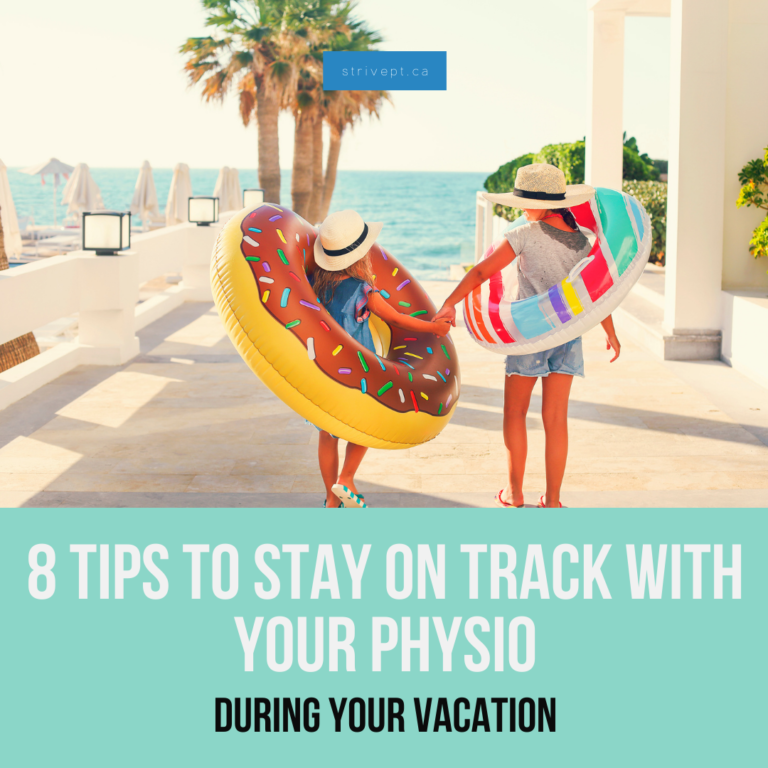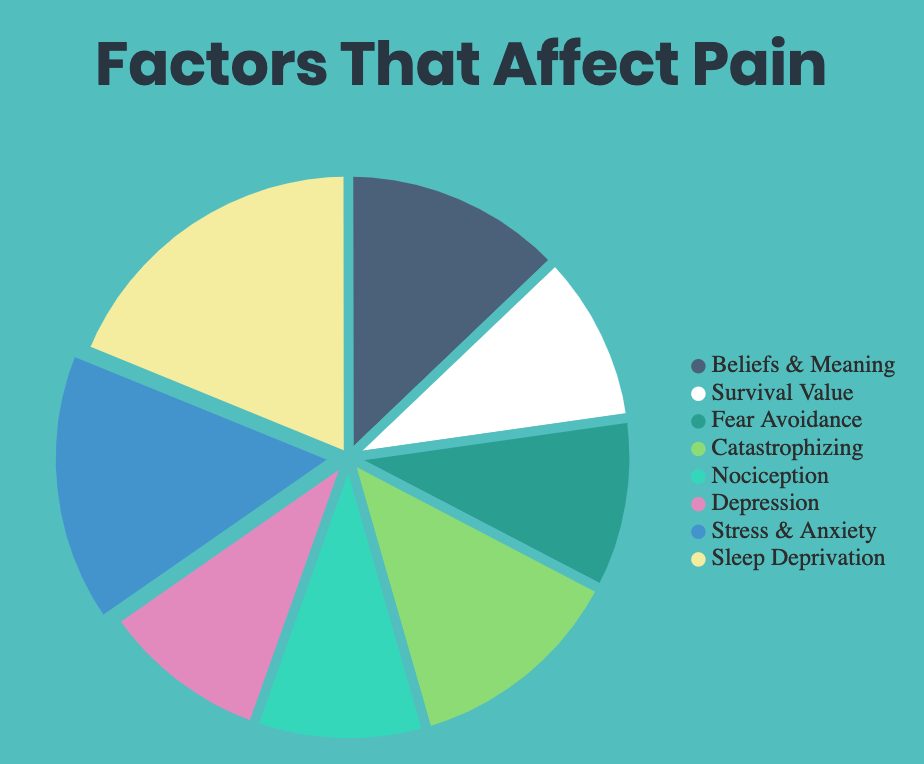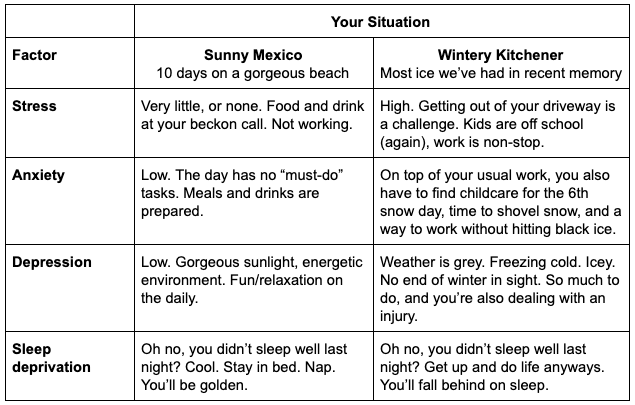
If you are recovering from an injury or surgery, going on a vacation may seem like a big pause button in your recovery. But it doesn’t have to be! Learn how to exercise during your vacation without changing your vacation plans.
If you’ve been anywhere around Strive Physiotherapy & Performance since Christmas 2018, there’s one thing you probably know:
I’m (Tyler) going to England! The number one item on my bucket list is about to be checked off (see the team section of our website – it’s in my profile!). In April 2019 I am going to see Manchester United play at Old Trafford. I love my wife (she organized it all).

(Cut me some slack, I’m excited).
I will be off work for two weeks, living that vacation life.
Over the past year, I’ve also (finally) been consistent at working out 3-5 days a week, and (thanks again, to my amazing wife) started eating more reasonably. That means I’ve become more physically fit, needed a new belt, and I’ve dropped 20 pounds in the past 12-13 months. I have more energy, I am more confident, and there might even be a single muscle somewhere on my body with a mild amount of definition.
I want to do my best to stay on track, without ruining my vacation spending hours in a gym, or not enjoying the luxuries of English cuisine (please let me know what that is).
I’m not the only one itchy for/planning/or about to leave on vacation. Winter has been brutal this year, so it’s time to escape! Many of our clients are mid-rehab when the vacation time hits, and no one likes setbacks. Here’s 8 ways to stay on track during your vacation!
Stay on Track with Exercise During Your Vacation
1. Take your bands
Exercise bands are often a critical tool in the rehab world. In many cases, your physiotherapist will have you performing exercises with a trusty, stretchy, exercise band. Not only are exercise bands extremely useful strength building tools, they’re extremely light, compactable, and safe for carry-on luggage!
So…. take them with you! Even the shopping-addicted vacationer can afford the 1-2 square inches and few ounces of weight the exercise band will take up. Moreso, seeing the band on the top of your luggage when you go to get dressed each day should help remind you to stay consistent with your rehab or strengthening exercises.
If dumbbells or other exercise equipment is required for your workouts, most hotels have gyms, so ensure you find out ahead of time. If you’re living that AirBnB lifestyle, and you have no idea what you’re gonna find when you get there, ask your physiotherapist for body-weight variations of your exercises, or tips/tricks on what else you could use to continue progressing.
2. Plan ahead
See point #1. Plan to take your bands (or other light, easily portable exercise equipment you may need). Plan to stay in hotels that have the gyms, pools, hot tubs, etc you need.
Also plan the days of your vacation. If 3 of your 7 days away have excursions planned, be sure to do your exercises the other 4 days. Plan ahead what times and days make the most sense to get in a workout or to do your rehab exercises. This is another great thing to do with your physiotherapist.
Plan ahead by asking questions:
What are the most important exercises that I must do every day?
Are there exercises I can skip while away?
How do I modify my exercises given scenario A, B, or C?
What happens if I just skip my exercises all together and do nothing while I’m away?
How soon should I book an appointment after my vacation?
3. Walk everywhere
Use this time to just CRUSH your buddies in a FitBit challenge. All those suckers will be at work, while you can be out enjoying the scenery, taking in a museum, or hiking a mountain.

Science has proven that walking and being out in nature can significantly improve mental, physical, and emotional well-being. Take advantage of that. Is there a 10-minute tube ride (England shout out!) to your destination? Awesome. Is it only a 25 minute walk? Even awesomer. Use this 25 minutes as a way of seeing new things, enjoying some fresh air, and burning some extra calories. Stairs or an elevator? Take the stairs.
4. Start your day off right
If your rehabilitation requires you to do your exercises daily, just do them right away. Roll out of bed, go pee, grab your exercise band, and pump out an underwear-clad, bright-eyed 2 sets of 8-10 reps. Getting your rehabilitation exercises done first thing will ensure they get done at least once that day, no matter what the day ends up having in store for you.
Doing a workout first thing in the morning can help wake you up, give you more energy, jumpstart your metabolism, and make you feel accomplished. Again, this ensures the rest of your day can be more unplanned, spontaneous, or relaxed. You won’t have to worry about getting a workout in later, leaving your poolside margarita, or saying no to an unexpected adventure.
5. Skip a meal
If weight-loss has been your primary goal with diet and exercise, vacation can be an absolute slaughterhouse for your success. In this case, many of the other things in this post can be helpful. Plan ahead (what food are you definitely going to crush, and what could you potentially live without), walk everywhere (get that leisure physical activity rolling, and burn calories at the same time), and start your day off right by exercising. Burning calories before the day really gets going could give you a head start on your caloric allowance.
Further, providing it’s safe for you (ask your healthcare provider), you could skip a meal. Skipping a meal allows you to eat bigger, more satisfying meals (or same size meals and extra desserts – booyeah), without taking in extra calories. This will allow you to say yes to the gelato in Italy, churros in Mexico, or beavertails in Ottawa.
My best friend has become a master of this. Guy just LOVES food. And dessert. And a good cocktail. That said he’s also a fitness professional and hates sabotaging his diet. On special occasions he’ll often skip both breakfast and lunch (he’s part alien), and eat his entire caloric allowance at dinner/dessert/cocktail time. It’s what he’s found works well for him. He goes to bed satisfied, and doesn’t feel an ounce of guilt about what he ate.
If you chose to do this, try filling your usual meal time with an activity. Play beach volleyball through your usual lunch time, or workout while others are eating breakfast. Distracting yourself can help you feel less hungry, and doing something physical will lead to even more calorie burn (i.e. an extra dessert!). Drinking lots of water to stay hydrated can also help curb your cravings.
6. Just do something
I wrote a blog on staying active when you have no time. Many of the concepts in this blog would also be applicable to staying on track while on vacation.
If you haven’t read that post, here are some quick tips from it:
- Every time you get out of a chair, do it twice
- Take the stairs
- Park at the back of the parking lot (walk everywhere!)
- Try keeping up with a toddler (or any kids for that matter)
- If you’re with your kids on vacation, chances are it’s “too boring” to sit in a lounge chair by the pool. Swim with them, play games with them, learn a new sport with them. Get your heart rate up with them!
- Walk on your lunch break (walk everywhere!)
- Find an exercise buddy
- Stay accountable with your vacation mates. Or get social and meet someone with the same ideas on fitness.
The key point here? Do something. Working on improving or maintaining your fitness, and don’t have 30 minutes to get in your normal 5km run? Run 2 km. Fast. Might take you 10 minutes instead. Everyone has 10 minutes. Or, for strength building, try a pyramid workout. Or as my best friend at JMaxFitness calls it, “The Travel Workout”.
It goes like this. Pick three exercises (preferably more whole body ones):
Squat
Push ups
Pull ups/Chin ups
Perform a 5-10 minute warm up, then pyramid your way from 1 rep of each exercise, then 2 reps of each, then 3 reps of each… up to 7 reps of each exercise. Then, work your way back down. 6 reps of each, 5 reps of each… and so on back to 1. All with no rest. Like this:
Set 1: 1 squat, 1 push-up, 1 pull-up
Set 2: 2 squats, 2 push-ups, 2 pull-ups
Set 3: 3 squats, 3 push-ups, 3 pull-ups
Set 4: 4 squats, 4 push-ups, 4 pull-ups
Set 5: 5 squats, 5 push-ups, 5 pull-ups
Set 6: 6 squats, 6 push-ups, 6 pull-ups
Set 7: 7 squats, 7 push-ups, 7 pull-ups
Set 8: 6 squats, 6 push-ups, 6 pull-ups
Set 9: 5 squats, 5 push-ups, 5 pull-ups
Set 10: 4 squats, 4 push-ups, 4 pull-ups
Set 11: 3 squats, 3 push-ups, 3 pull-ups
Set 12: 2 squats, 2 push-ups, 2 pull-ups
Set 13: 1 squat, 1 push-up, 1 pull-up
Warm up included, this will take 15-20 minutes, and you’ll be gassed. It’s simple, effective, and easily modifiable.
If you’re focusing primarily on rehabilitation (i.e. less intense than the fitness workouts listed above), still aim to do something. If you’re physiotherapist instructed you to perform 2 sets of 10 reps of your exercises twice per day, but vacation is busy, do your exercises once per day.
Do less reps, less sets, if you absolutely have to. But, in the end, do something.
This also goes back to the good, clear, conversation you should have with your physiotherapist. Ask what modifications can be made in the short term, and work together to set a realistic and attainable goal! If you know you won’t do your exercises everyday, tell your therapist that. They can help you set up a more appropriate program in the short term. That way, expectations are set, guilt is dissolved, and progress will continue.
7. Take more vacation
As physiotherapists, we often hear: “When I was away, I felt great! No knee pain at all. And I was active. I’ve been back for three days and now I have pain again! What’s that all about!?”

Although there can be a plethora of things playing a role in this “pain-free” experience, a good starting point is understanding pain, and what causes pain.
Firstly, pain is an experience. It’s a feeling, and it’s an output from the brain. The brain sends pain to the area of the body it is trying to protect. Our brain sends out pain as a response to threat. This threat can be very real (like a burn, wound, broken bone), or perceived (the brain thinks something bad has happened, or is about to happen).
This pain is associated with actual, or potential damage. Meaning we can feel no pain at all despite having “tissue damage”. (Ever cut your finger, carry on what you’re doing, just to realize you’ve been getting blood on everything for 5 minutes?). It also means that we can feel intense pain, without any real tissue damage. Like I said, pain is complicated, and we’ve written a blog exclusively on pain if you want to know more.
In short, pain is a bio-psycho-social experience.
The output of pain is determined by our:
- Biology (i.e. nociception, immune status)
- Psychology (i.e. mood, personality)
- Social experience (i.e. past experience, social/learned expectations)
Why does all this matter when talking about simply having less pain while on a beach in Mexico? Here’s an example:

Note: the percentages and pie slice sizes are hypothetical and completely made up. They would be different for every person, every day.
As we can see in the picture, on top of nociception (the “biology” part of pain), things such as stress, anxiety, depression, and sleep deprivation, can play a role in pain.
To keep it simple: when amounts of stress, anxiety, depression, and sleep deprivation are elevated, pain is typically elevated. Let’s compare.

This can be why pain is lower on vacation. Although the biological aspect of your injury/pain is still present, the other things often associated with painful experiences are lessened.
So, take more more vacation. If you’re allotted the vacation days (and taking time off won’t have a reverse effect on stress/anxiety etc), then use your days! North Americans take significantly less vacation than the average person in Europe. Get out an unwind. It’ll do you some good.
8. Don’t worry about it
If you’re doing therapy or recovering from a specific injury, then please discuss this with your physiotherapist. BUUUUTTTTT… would it really matter if you just took some time off and had fun? Seriously, is your vacation 4 days and 3 nights over a long weekend? Many times the full blown, worry-free, complete zen-out can be good for you. Just make sure you get back on track when you get home.
Everything in life is moderation. 80% of the time, behave and make the healthier choice. 20% of the time, let loose, eat the cake, skip a workout to see a movie with friends, or let it all go for your vacation.
Maybe the 20% “unhealthy” choice, is actually the healthy one.
We’re only human after all.
Still not sure what to do to best prepare for your time away? Call us at 519-895-2020, or use our online booking tool on www.strivept.ca to book an appointment with one of our knowledgeable physiotherapists, and they will be sure to help you understand your injury.
Cheers,
Tyler Allen
Physiotherapist at Strive Physiotherapy and Performance